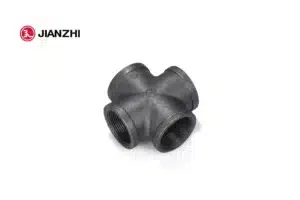In the realm of fire protection systems, the choice of materials for fire pipe fittings plays a crucial role in ensuring both safety and reliability. Among the various fire pipe fittings types, black fittings for fire protection equipment have gained prominence due to their unique advantages. Made from malleable materials, these fittings stand apart from other options, such as galvanized pipe for fire protection equipment, offering distinct features that make them ideal for fire suppression applications.

Fire Pipe Fittings Types
Fire pipe fittings are essential for connecting various components of fire protection systems, including pipes, valves, sprinklers, and hydrants. The materials used in these fittings determine their performance under extreme conditions. The most common types of fire pipe fittings include:
Black Fittings for Fire Protection Equipment: These are made from malleable cast iron, offering flexibility and strength under high pressure and heat.
Galvanized Pipe for Fire Protection Equipment: These pipes are coated with zinc to resist corrosion, providing durability in environments where moisture exposure is a concern.
Copper and Brass Fittings: Although less frequently used in large-scale fire protection systems, copper and brass offer excellent corrosion resistance in certain specialized applications.
Why Black Fittings Stand Out in Fire Protection Systems
Black fittings are typically made from malleable cast iron, a material that is known for its strength, flexibility, and resistance to wear. These fittings are designed to perform under the extreme conditions of fire suppression systems, where high pressure and heat are common.
The malleable nature of black fittings allows them to be easily installed and adapted to fit specific system configurations. This material flexibility is particularly valuable in systems that require precise connections between components, ensuring tight, leak-free seals under pressure. Unlike other fittings, black fittings can also withstand the intense heat generated during fire emergencies, making them an ideal choice for high-temperature environments.
Black Fittings vs. Galvanized Pipe
Both black fittings for fire protection equipment and galvanized pipe for fire protection equipment have their place in fire protection systems, but their applications differ depending on environmental conditions.
Galvanized pipes are coated with zinc to prevent rust and corrosion, making them highly suitable for environments where moisture or chemicals are prevalent. However, while galvanized pipes excel in damp or outdoor settings, the zinc coating can degrade when exposed to extreme temperatures during a fire, potentially compromising the pipe’s integrity. Additionally, the zinc coating may emit harmful gases when exposed to fire, posing a risk to health and safety.
On the other hand, black fittings made from malleable cast iron are not coated, which allows them to remain stable and reliable even at elevated temperatures. These fittings maintain their strength and shape during fire suppression operations, providing better performance in high-temperature scenarios.
Furthermore, black fittings are more adaptable when it comes to installation. The malleable material allows for easy modification and precise connections, ensuring a more customized fit for fire protection systems.
Versatility and Performance of Malleable Black Fittings
The key advantage of black fittings for fire protection equipment lies in their versatility and superior performance. Due to the malleable nature of the material, these fittings can be used in a wide range of fire pipe fittings types, including elbow joints, tees, reducers, and couplings. Their ability to handle high-pressure water flow, combined with their exceptional heat resistance, makes them indispensable in systems where reliability is critical, such as in commercial, industrial, and residential buildings.
In contrast, galvanized pipes for fire protection equipment are primarily chosen for their corrosion resistance and are often used in areas where exposure to moisture is a concern. However, their inability to withstand extreme temperatures as effectively as black fittings makes them less suitable for high-heat environments.
Maintaining and Replacing Fire Pipe Fittings
Both black fittings for fire protection equipment and galvanized pipe fittings are designed for ease of maintenance and replacement. The malleable nature of black fittings allows for simple installation and quick adjustments, which is especially beneficial during maintenance or system upgrades. Additionally, these fittings are robust enough to endure long-term use, ensuring minimal downtime and reduced maintenance costs.
Galvanized pipe fittings, while durable, can sometimes present challenges when repairs are needed, especially if the zinc coating has been damaged or compromised. In such cases, replacing galvanized fittings may require more time and effort, as the zinc coating must be carefully removed to prevent further corrosion.
Conclusion
Both black fittings for fire protection equipment and galvanized pipe for fire protection equipment offer distinct benefits, but black fittings made from malleable cast iron are particularly well-suited for high-pressure, high-temperature environments. Their flexibility, strength, and heat resistance make them an essential choice for fire protection systems, ensuring reliability when it matters most.
When selecting fire pipe fittings, it’s important to consider the specific needs of your system, including the environmental conditions and performance requirements. Black fittings stand out as a reliable, versatile, and high-performance solution for fire protection, providing long-lasting safety and peace of mind.
About Us
For more information on the different types of fire pipe fittings and to find the best solution for your fire protection system, contact our team of experts for personalized advice and support.
